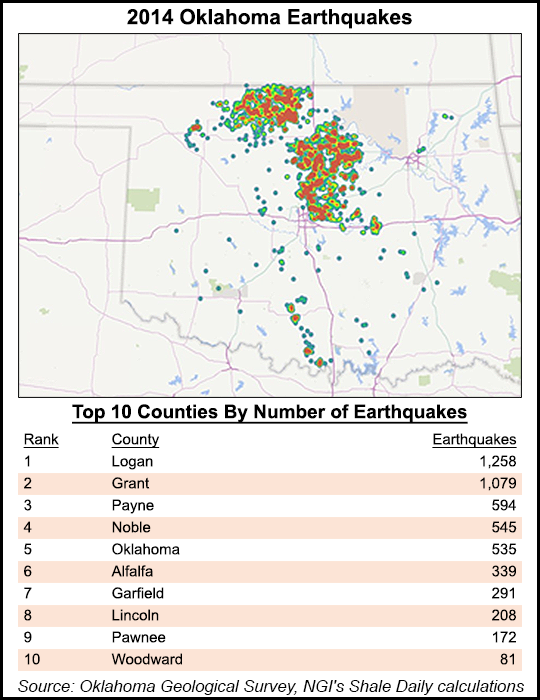E&P | NGI All News Access | NGI The Weekly Gas Market Report
Tremors Move Kansas, Oklahoma to Restrict Injection Well Activity
Seismic activity in Kansas has been on the rise for a while and has been blamed on drilling waste injection wells, so state regulators recently acted to limit injection volumes where tremors have been prevalent. And in neighboring Oklahoma, injection well operators were recently required to limit the depth of their disposals.

“Because individual earthquakes cannot be linked to individual injection wells, this order reduces injection volumes in areas experiencing increased seismic activity,” the Kansas Corporation Commission (KCC) said. “The commission retains jurisdiction to amend this order as new information becomes available.”
The order cites statistics from the U.S. Geological Survey that shows from 1981 through 2010, Kansas had 30 recorded earthquakes. However, in 2013 alone there were four recorded quakes in the state. “The number of recorded earthquakes in Kansas during 2014 increased to 127,” the order said. “From Jan. 1, 2015 to March 16, 2015, Kansas has experienced 51 recorded earthquakes. The majority of the earthquakes have occurred in Harper and Sumner counties.”
The state recently formed a task force to study induced seismicity that includes the participation of the Kansas Geological Survey (KGS), KCC and Kansas Department of Health and Environment. Besides an increase in seismicity in Harper and Sumner counties, researchers also found an increase in injection well activity.
Harper County went from 44 injection wells in 2010 to 71 in 2013, and there were 18 permit applications received for new wells last year alone, according to KCC. “The number of barrels of saltwater injected in Harper County increased from 9,671,655 in 2010 to 51,827,349 in 2013,” the order said.
In Sumner County, the number of injection wells climbed from 53 in 2010 to 79 in 2013, and 17 new well permit applications were received last year. “The number of barrels injected in Sumner County increased from 9,763,265 in 2010 to 10,722,360 in 2013,” the order said.
The task force came up with what it calls a seismic action score to enumerate the significance of quakes. From the first of this year until March 16, there were 113 quakes in the state that had a score of 17 or higher. A score of 17 or higher triggers notification to the KCC by the KGS and regulatory action is considered.
“Commission staff, in consultation with the KGS, recommended, and the commission finds, there are areas in Harper and Sumner counties which are more seismically active and potentially prone to induced seismic events. These areas require immediate action with regard to the operation of Class II injection wells.”
The order sets out restrictions that injection well operators must follow when injecting into the Arbuckle Formation. It applies to “large volume” injection wells defined as those injecting 5,000 barrels of saltwater or more per day. For certain wells within three miles of an area described in the order allowable injections are to be scaled down from 16,000 barrels per day to 8,000 barrels per day over several months. Restrictions also were placed on injection pressures.
Meanwhile in Oklahoma, the Oil and Gas Conservation Division (OGCD) of the state’s Corporation Commission issued new rules for Arbuckle Formation injection wells. Disposal well operators in “areas of interest” that inject into the Arbuckle Formation (the state’s deepest formation) have until April 18 to prove to the OGCD that the well is not disposing below the Arbuckle. “There is broad agreement among seismologists that disposal below the Arbuckle poses a potential risk of causing earthquakes as it puts the well in communication with the solid ‘basement’ rock,'” OGCD said.
Oklahoma’s order applies to about 347 of approximately 900 Arbuckle disposal wells in the state, according to OGCD.
Last fall, Oklahoma regulators shut in a disposal well that was thought to have been drilled to deep following a spate of seismic activity in the area (see Shale Daily, Oct. 31, 2014).
© 2024 Natural Gas Intelligence. All rights reserved.
ISSN © 2577-9877 | ISSN © 1532-1266 | ISSN © 2158-8023 |
